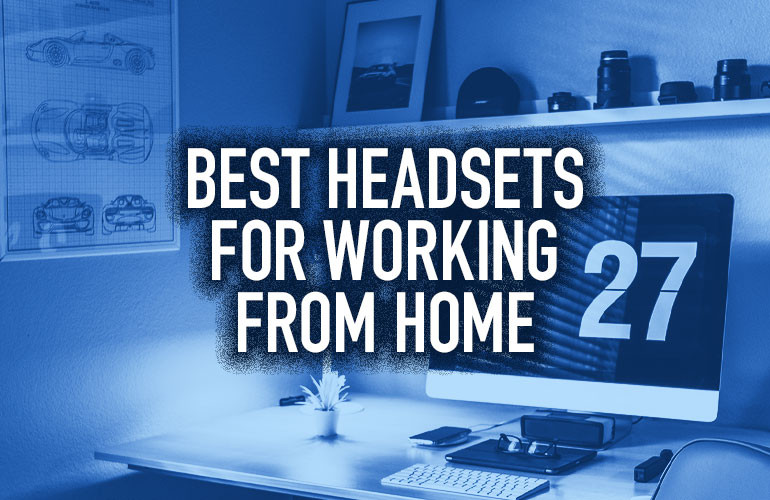We don’t need to tell you why — home offices are a necessity right now.
When working from home, you need professional audio communications. In other words, you need a headset.
Where do you start? What questions should you be asking before buying a home worker headset?
Here’s a helpful shopping guide for finding the best home office headsets.
Home Office Headset Buyer’s Guide
- Connection Type
- Wired vs Wireless
- Mono vs Stereo
- Noise Cancellation
Connection Type
For most home office setups, you can focus on two connection options: wired USB headsets or wireless Bluetooth headsets.
USB headsets come in two varieties: USB-A and USB-C.
USB-A is the familiar USB version.
Newer computers like recent Macbooks have USB-C ports. It took a bit, but there are now many USB-C headsets for the home office.
When shopping for USB headsets for teleworkers, it’s a good idea to check if there are inline call controls or call controls integrated in a headphone. Integrated call control makes it easier to answer or end a call, mute the mic, and so on.
If you or your business have an existing headset that you want to use, it might not have USB connectivity. In this case, see if there’s a headset adapter like Plantronics DA70 or Jabra Link 230 that can adapt RJ9, Quick Disconnect, or other connectors to USB.
If you have an IP phone, you’ll have to check with the manufacturer for headset compatibility.
Wired vs Wireless
Wired USB headsets are simpler to use and less expensive, when comparing headsets in the same class.
Wired USB headsets are simpler to use because they’re a plug-and-play solution. At most, you’ll need to switch the computer’s audio input/output to the headset.
Almost any USB headset will be compatible with almost any softphone. However, there may be exceptions. Doublecheck with the service provider for compatibility before buying the headset.
If you want full call control with Microsoft Office 365 apps like Teams, look for Microsoft Certified headsets. Both Plantronics (Poly) and Jabra offer Microsoft Certified headsets for home use.
Wireless Bluetooth headsets maximize convenience and are good for mobile devices.
If you’re a pacer while you work, you’ll want a wireless headset for the home office. Or maybe you need to check on the kids. With a wireless headset, you’ll always be in touch.
Another reason to go wireless is that you want to use the headset with a mobile device: smartphone or tablet. In this case, look for a Bluetooth headset.
A headset like Plantronics (Poly) Voyager 8200 works with almost any mobile device.
(There are also wireless headsets that use DECT instead of Bluetooth. These headsets communicate with a base station that connects to a computer. Their advantages include reducing spectrum density and extended wander range, neither of which is important for the home office.)
Mono vs Stereo
Do you want a headset with one headphone (mono or monaural) or two (stereo or binaural)?
Mono headsets let you stay in touch with your surroundings. In general, they are less expensive and lighter than stereo headsets, because they lack the extra speaker.
If you’re looking for a budget friendly headset for home office, look for a mono headset. If you wear a headset all day, it might be more comfortable to choose a light headset.
Headsets that meet both criteria — cost and comfort — include Plantronics (Poly) Blackwire 3210 and Jabra BIZ 1500.
Stereo headsets improve focus by blocking out noise better. This makes sense, as both your ears are covered.
They also provide better audio quality for listening, because of the extra speaker and improved noise blocking.
If you like to listen to music as you work, but you still want a professional communications headset, you’ll probably want a stereo headset like the cost-effective Jabra Evolve 30 II.
Noise Cancellation
There are two types of noise cancellation: active and passive.
Active noise cancellation is useful when you work in a noisy environment.
Let’s say you have kids at home and they’re running around even though the cartoons are blaring and — well, it’s not an atmosphere conducive to productivity. Or maybe there’s construction outside and you want relief from the sound of the jackhammer.
Active noise cancellation is your best friend.
In general, it works like this. The headset interprets incoming audio (like your kid’s shrieks) and produces a counterbalancing sound, which acts like audio camouflage.
The effect is greatly reduced noise. Headsets like Plantronics (Poly) Blackwire 7225, which offers active noise cancellation on top of hi-fi stereo sound, can really make your life better.
Passive noise cancellation typically means one of two things.
First, it can mean that a stereo headset blocks out noise by covering both ears. The fact that your ears are covered means that noise is blocked “passively.”
Second, it can mean that the microphone is directional. In other words, it is designed to pick up only audio from your mouth and not from the surroundings.
A well-designed microphone or microphone array, like the 3-microphone system used by Jabra Engage 50, really improves audio quality.
These are the features that we feel are the most important to consider when shopping for a home office headset.
If you’d rather speak with a headset expert, get in touch:
- Call us at (888) 201-9056
- Email us at service@ipphone-warehouse.com

